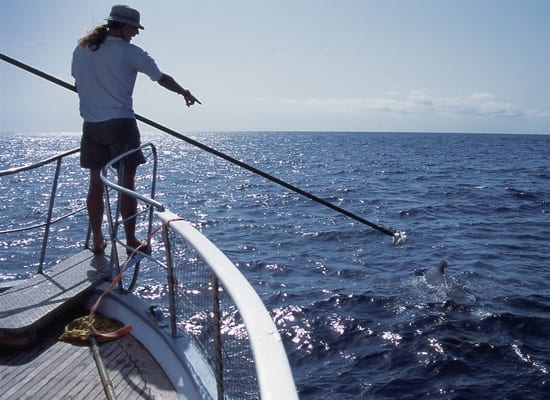Cheetahs of the Deep
May 28, 2008
A new study has revealed that pilot whales are “the cheetahs of the deep sea,” making high-speed, all-or-nothing dives to chase and catch large prey before surfacing to catch their breath. Such sprinter-like dives stand in stark contrast to the longer, slower, and more conservative dives of other whale species that have been studied.
Marine mammal researchers working off the Canary Islands attached non-invasive, temporary tags–known as D-tags–to 23 whales to digitally record movements during their 15-minute dives, as well as the sounds that they make and hear. Researchers analyzed the recorded “clicks,” “buzzes,” and other whale sounds–together with the whales’ recorded speeds, orientations, and depths–to reconstruct a picture of the whales’ hunts.
That picture shows pilot whales diving down to about 1,640 feet (500 meters) and then leveling out to select a target; large squid are believed to be a favorite. Once they have picked their prey, a chase starts that can take the whales to 3,000 feet (1,000 meters) depth and speeds up to 20 miles per hour (9 meters per second).
Most of the deep-diving whales studied to date swim at only 1 to 2 meters per second, allowing them to conserve energy and oxygen and to maximize hunting time in the depths. “The sprints of these short-finned pilot whales open a new perspective into optimal foraging theories of deep-diving, breath-holding mammals,” said Natacha Aguilar de Soto of the University of La Laguna, lead author of the study.
“The D-tag was the first instrument to capture an echo from prey in the wild, one of the great challenges in studying echolocation,” said Peter Madsen, a professor at the University of Aarhus (Denmark) and one of the study’s authors. “It is a really unprecedented chance to study how whales find and capture their dinner.”
“What’s cool is to ‘see’ how whales hunt at depth using their own sounds—without the intrusion of lights and a camera,” said Mark Johnson, a bio-engineer at the Woods Hole Oceanographic Institution and inventor of the D-tag.
The study by Aguilar de Soto, Johnson, and colleagues was published online in the Journal of Animal Ecology.
The new observations should help scientists reinterpret thinking about the whales’ behavior. Pilot whales often congregate in groups at the surface and have a reputation for being calm, approachable, and not bothered by boat activity. Instead, they may just be too tired to react. The new understanding about whale diving and feeding behaviors should also inform policies to better manage whale-watching and shipping movements in areas with whales.
Support for this research was provided by the U.S. Department of Defense, the U.S. National Oceanographic Partnership Program, and the Canary Islands Government-Spanish Ministry of Defense.
Related Links

